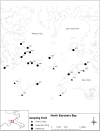Shoreline oiling effects and recovery of salt marsh macroinvertebrates from the Deepwater Horizon Oil Spill
- PMID: 28828273
- PMCID: PMC5563157
- DOI: 10.7717/peerj.3680
Shoreline oiling effects and recovery of salt marsh macroinvertebrates from the Deepwater Horizon Oil Spill
Abstract
Salt marshes in northern Barataria Bay, Louisiana, USA were oiled, sometimes heavily, in the aftermath of the Deepwater Horizon oil spill. Previous studies indicate that fiddler crabs (in the genus Uca) and the salt marsh periwinkle (Littoraria irrorata) were negatively impacted in the short term by the spill. Here, we detail longer-term effects and recovery from moderate and heavy oiling over a 3-year span, beginning 30 months after the spill. Although neither fiddler crab burrow density nor diameter differed between oiled and reference sites when combined across all sampling events, these traits differed among some individual sampling periods consistent with a pattern of lingering oiling impacts. Periwinkle density, however, increased in all oiling categories and shell-length groups during our sampling period, and periwinkle densities were consistently highest at moderately oiled sites where Spartina alterniflora aboveground biomass was highest. Periwinkle shell length linearly increased from a mean of 16.5 to 19.2 mm over the study period at reference sites. In contrast, shell lengths at moderately oiled and heavily oiled sites increased through month 48 after the spill, but then decreased. This decrease was associated with a decline in the relative abundance of large adults (shell length 21-26 mm) at oiled sites which was likely caused by chronic hydrocarbon toxicity or oil-induced effects on habitat quality or food resources. Overall, the recovery of S. alterniflora facilitated the recovery of fiddler crabs and periwinkles. However, our long-term record not only indicates that variation in periwinkle mean shell length and length-frequency distributions are sensitive indicators of the health and recovery of the marsh, but agrees with synoptic studies of vegetation and infaunal communities that full recovery of heavily oiled sites will take longer than 66 months.
Keywords: Deepwater Horizon oil spill; Fiddler crab; Littoraria irrorata; Marsh periwinkle; Uca.
Conflict of interest statement
The authors have no competing interests. Donald R. Deis and Stefan M. Bourgoin are employees of Atkins, Inc.
Figures








References
-
- Alexander SK, Webb JW. Relationship of Spartina alterniflora growth to sediment oil content following an oil spill. Proceeding of the international oil spill conference, April 1987, vol. 1987, no. 1; 1987. pp. 445–449. - DOI
-
- Baca BJ, Lankford TE, Gundlach ER. Recovery of Brittany coastal marshes in the eight years following the Amoco Cadiz incident. Proceedings of the international oil spill conference, April 1987, vol. 1987, no. 1; 1987. pp. 459–464. - DOI
-
- Baker MC, Steinhoff MA, Fricano GF. Integrated effects of the Deepwater Horizon oil spill on nearshore ecosystems. Marine Ecology Progress Series. 2017;576:219–234. doi: 10.3354/meps11920. - DOI
-
- Bennett A, Bianchi TS, Means JC, Carman KR. The effects of polycyclic aromatic hydrocarbon contamination and grazing on the abundance and composition of microphytobenthos in salt marsh sediments (Pass Fourchon, Louisiana) I: a microcosm experiment. Journal of Experimental Marine Biology and Ecology. 1999;242:1–20. doi: 10.1016/S0022-0981(99)00091-X. - DOI
-
- Bertness MD. Fiddler crab regulation of Spartina alterniflora production on a New England salt marsh. Ecology. 1985;66:1042–1055. doi: 10.2307/1940564. - DOI
LinkOut - more resources
Full Text Sources
Other Literature Sources

